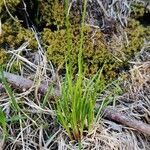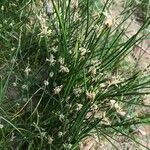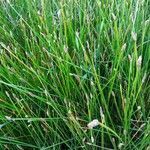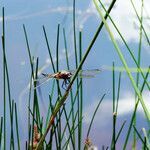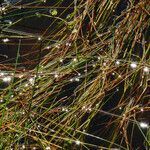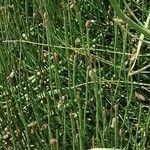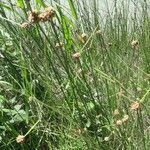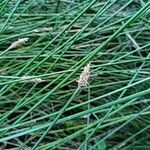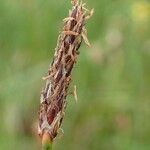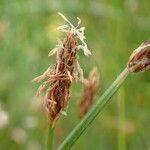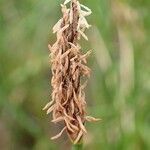Rhizomatous perennial; stems scattered or in small clusters, 1–10 dm, slender to very stout; spikelet 5–40 mm, lanceolate to lance-ovate in outline, light to dark brown or chestnut; empty scales (glumes) at the base of the spikelet 1 or 2(3), when solitary commonly ± encircling the stem at base, when 2 or 3 generally extending only ca half-way around, but the lowest one even then sometimes encircling; fertile scales mostly 2–4.5 mm; bristles 4(–8), retrorsely barbed, shortly surpassing the achene, or sometimes reduced or obsolete; anthers 1.3–2.5 mm (dry); style bifid; achene lenticular, yellow to medium-brown, 1–2 mm, very finely cellular-roughened; tubercle 0.4–0.7, constricted at base, narrow and conic to depressed-deltoid; 2n=10–92; a polyploid complex with a degree of morphologic-cytologic-geographic differentiation, but the subgroups apparently inextricably linked, and not yet satisfactorily sorted out into proper infraspecific taxa. Wet places, tolerant of salt and alkali; circumboreal, s. in e. U.S. to Va., Tenn., and Mo. (E. smallii, widespread with us, biglumate, much like European E. palustris proper; E. macrostachya, western, biglumate; E. uniglumis, European, with a single encircling glume; E. halophila, mainly of coastal salt-marshes, much like E. uniglumis, uniglumate, the scales ± tapering to an acute or subobtuse tip; E. erythropoda (E. calva), widespread with us, uniglumate, the scales all broadly rounded or obtuse)
Perennials. Rhizomes creeping. Culms a few tufted, 10-100 cm tall, 2-3 mm thick, few ribbed and longitudinally sulcate, obscurely tuberculate. Leaf sheaths 1 or 2, basally blood-red purple, tubular, 3-7 cm, mouth slightly obliquely truncate. Spikelet oblong, narrowly oblong, or ellipsoid, 0.6-2.5 cm × 3-5 mm, many flowered, apex obtuse-rounded. Basal 2 glumes empty; basalmost glume amplexicaul for 1/2 or more of spikelet base; fertile glumes with a narrow green band medially and dark blood-red on sides, ovate to ovate-lanceolate, 3-4 × 1-1.5 mm, membranous, margin broadly hyaline, apex obtuse. Perianth bristles 4-6, shorter to slightly longer than nutlet, slightly curved, spreading outward, densely retrorsely spinulose. Stigmas 2. Nutlet at first yellowish then becoming brownish, obovoid, broadly obovoid, or globose-ovoid, 1.2-1.4 × 0.8-1 mm, unequally biconvex, smooth or rarely slightly prominently reticulate; persistent style base ovoid-oblong to oblong-conic, much longer than wide, 1/2-3/5 as long and ca. 1/2 as wide as nutlet, spongy, apex obtuse to rounded. Fl. and fr. Jun-Jul. 2n = 15, 16.
